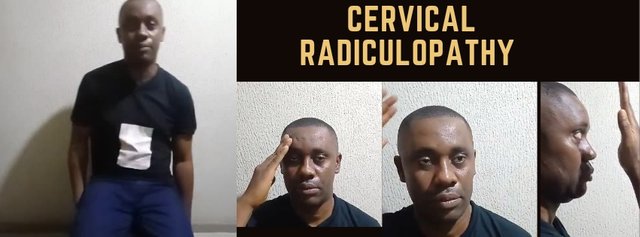Steemit Learning Challenge-S21W3; Cervical Radiculopathy"
Welcome friends!
It is another interesting week to share with us physical therapy intervention. And at this time, I. will be sharing my views on Cervical Radiculopathy.
 |
|---|
Cervical Radiculopathy is a medical condition that happens when there is an irritation in one of the nerves around the neck region. This is where we have the cervical spine, and each time there is a trigger within this region, it brings ls about pains, numbness, and weakness around the arm or shoulder areas. This can be identified or, rather, comes sometimes with excruciating pains depending on the time of pain initiation.
Symptoms vary depending on how this pain has continued over time. This acute pain sometimes makes it difficult to carry out our daily activities. Some of the causes of cervical Radiculopathy are tumors, trauma, disc herniation, Osteoarthritis, etc. However, we can help manage and treat cervical Radiculopathy through physical therapy, medications, and surgery.
Disc Herniation usually occurs by the compression of nerves by the bulged spinal disc. Trauma/Injury as we know, may be a resultant effect of injury at the neck region that causes swelling and other changes. We shouldn't forget that age-related diseases can also cause this. In all of these, the C6 and C7 are the most affected nerve types that give us this excruciating pain.
We can also do ourselves good by preventing this painful ailment. Having a good ergonomic (posture position) is ideal for preventing this painful condition from occurring. Also is exercising ourselves by strengthening the neck and back regions. Most importantly, we have reduce lifting heavy items
Clinical Investigation
Through NCS (Nerve Conduction Studies).
This is a situation where the nerves are subjected to electrical conduction to check for any malfunction among themThrough MRI (Magnetic Resonance Imaging).
This is a process that helps give detailed and pictorial clarity to the cervical region. Helps detect the actual cause of this cervical Radiculopathy through imaging capture and interpretation.Through CT (Computed Tomography) Scan.
Offers additional imaging representation by giving the cross-sectional imaging details of the spine region.Through EMG (Electromyograpghy).
A process that helps deteçt the electrical activities of spine nerves. And in doing so, we could know which nerve is active or damaged.
Assessment Tests
We have the Spurling Test.
This is by rotating one's neck towards the area with pain. If truly there is Radiculopathy, acute pain can be triggeredWe have the Shoulder Abduction Test.
This is a test that allows the patient to place their arms in positions that reduce nerve tingling pains.Other spine tests that are carried out to help determine ranges during arm motion. We can detect pain areas from such tests.
The Trapezoius, Scalene, Levator Scapulae Stretch
This is coming first in my exercise for the week due to the impact and stretch. I had to stretch the other left arm after capturing my videos for the lessons. It was relieving for my neck and muscles.
The Isometric Neck Extension
This involves pulling back the neck but with the support of the arm at the back of the head. This helps stretch and neck muscles.
Isometric Neck Flexion
The slight up-and-down movement of the neck helps stretch the muscles in that region. It improves the flexibility of the neck.
Isometric Cervical Rotation
When a patient has difficulty performing a normal range of motion, this helps to improve that. This can be done on both sides to stretch neck muscles and improve motion.
The essence of this exercise is to ameliorate any possibility of cervical radiculopathy. In all of my practices made, they were all tailored towards stretching of neck muscles, and flexibility for adequate range of motion.
However, I felt some little tension in my system as I stretched, especially the Trapezoius-Scalene-Levator Scapulae. That was a full stretch of the muscle area. And I had to carry out each exercise between 15 - 30 seconds.
However, there was free movement of the neck muscles and shoulders. We usually don't know we need these exercises until we indulge and get performance.
In summary, physical therapy of this kind helps to manage effectively the occurrence of cervical radiculopathy. Maintaining any of these exercises would help improve our well-being as this helps us to stay away from discomforting pains.
Thank you, friends.
I appreciate your teachings @ashkhan
I invite @shiftitamanna, @rosselena, and @m-do
Sin duda que este es un taller muy provechoso para todos ya que aprendemos a realizar estos movimientos que nos ayudan a mejorar nuestros músculos o a aliviar alguna dolencia que tengamos
Mucha suerte en tu participación
https://x.com/xkool24/status/1856956205756768281?t=-88CL17UtmupgLapXpPjYg&s=19
Thank you for understanding the lesson and sharing your assignment; I hope that you will enjoy this week's lesson and try to implement it in your life if you see any such case.
Observations
Task 1 (2.9/3)
You have shared a good knowledge about cervical radiculopathy, and it's cause, symptoms, treatment, but you have to add the second name of cervical radiculopathy & I appreciate your effort.
Task 2 (3/3)
In the second question, you tell us about how you have to assess a patient by doing the physical examination, history taking, investigations of patients and specialized tests. You have share good knowledge. Excellent.
Task 3 (2/4)
You try the isometric cervical rotation, flexion, extension and trapezoius stretch. But while performing Isometric exercises you have to apply resistance & apply that much force that didn't allow head movement. You only perform trapezoius stretch in a correct way. Remember always apply heating pad to relax your muscles before performing these exercises. I appreciate your efforts.
Overall you made a great attempt to answer all the questions except question 3. I appreciate your efforts. But next time try to avoid the above written suggestions. Keep learning and try to implement your knowledge to the people suffering from any cervical radiculopathy. Thank you.